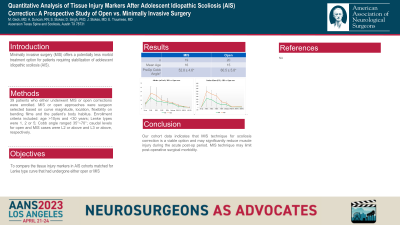Quantitative Analysis of Tissue Injury Markers After Adolescent Idiopathic Scoliosis (AIS) Correction: A Prospective Study of Open vs. Minimally Invasive Surgery
Friday, April 21, 2023


John Stokes, MD
Neurosurgeon
Ascension Texas Spine and Scoliosis
Austin, Texas, United States
ePoster Presenter(s)
Introduction: To compare the tissue injury markers in adolescent idiopathic scoliosis (AIS) cohorts matched for Lenke type curve that had undergone either open or minimally invasive surgery (MIS)
Methods: 39 patients who either underwent MIS or open corrections were enrolled. MIS or open approaches were surgeon selected based on curve magnitude, location, flexibility on bending films and the patient’s body habitus. Enrollment criteria included: age>10yrs and < 30 years; Lenke types were 1, 2 or 5; Cobb angle ranged 35°~70°; caudal levels for open and MIS cases were L2 or above and L3 or above, respectively.
Results: MIS and open groups comprised of 19 and 20 patients, respectively. Mean patient age was 16 in MIS and 15 years in open. Mean pre-op Cobb angles for MIS and open differed significantly (52.8±4.6° vs. 60.5±5.8°). Number of spinal levels treated were similar between the two groups. Mean surgical time, blood loss and length of hospital stay were significantly greater for the open group. Compared to the baseline, mean serum aldolase and creatine kinase were significantly higher on post-op day 2 for both groups. For all visits, open had comparatively higher mean serum aldolase levels than their counterparts. Mean serum creatine kinase for open was significantly higher than MIS at post-op days 1, 2, 3, 5 and discharge. Both markers returned to the normal levels for both groups at visits 3-week, 3- and 6-months post-op. Patient-reported pain and disability scores were similar. Both groups reported one complication each which resolved with interventions.
Conclusion : Our cohort data indicates that MIS technique for scoliosis correction is a viable option and may significantly reduce muscle injury during the acute post-op period. MIS technique may limit post-operative surgical morbidity.
Methods: 39 patients who either underwent MIS or open corrections were enrolled. MIS or open approaches were surgeon selected based on curve magnitude, location, flexibility on bending films and the patient’s body habitus. Enrollment criteria included: age>10yrs and < 30 years; Lenke types were 1, 2 or 5; Cobb angle ranged 35°~70°; caudal levels for open and MIS cases were L2 or above and L3 or above, respectively.
Results: MIS and open groups comprised of 19 and 20 patients, respectively. Mean patient age was 16 in MIS and 15 years in open. Mean pre-op Cobb angles for MIS and open differed significantly (52.8±4.6° vs. 60.5±5.8°). Number of spinal levels treated were similar between the two groups. Mean surgical time, blood loss and length of hospital stay were significantly greater for the open group. Compared to the baseline, mean serum aldolase and creatine kinase were significantly higher on post-op day 2 for both groups. For all visits, open had comparatively higher mean serum aldolase levels than their counterparts. Mean serum creatine kinase for open was significantly higher than MIS at post-op days 1, 2, 3, 5 and discharge. Both markers returned to the normal levels for both groups at visits 3-week, 3- and 6-months post-op. Patient-reported pain and disability scores were similar. Both groups reported one complication each which resolved with interventions.
Conclusion : Our cohort data indicates that MIS technique for scoliosis correction is a viable option and may significantly reduce muscle injury during the acute post-op period. MIS technique may limit post-operative surgical morbidity.
